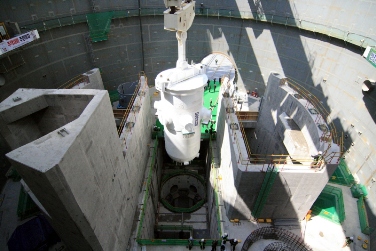National electricity plans to help mitigate climate change announced by the South Korean government include ambitions for nuclear to contribute nearly half the country's electricity generation by 2022.
 |
| One of many: The reactor vessel of Shin-Kori 1 during installation in May 2008 (Image: KHNP) |
South Korea is to invest 37 trillion won (about $28.5 billion) in increasing generation capacity over the period to 2022 to meet an electricity demand expected to grow at 2.1% per year over the period. The plan includes the establishment of 12 nuclear power reactors, 7 coal-fired units and 11 liquefied natural gas (LNG) units.
This, said the MKE, would mean that by 2022 nuclear power 48% of all electricity generated, up from 34% today. Shares of 29% and 23% respectively would see coal- and gas-fired plants accounting for slightly less of Korea's total capacity than at present, but LNG's contribution to total electricity generated would fall significantly from its current 22% to only 6% by 2022.
According to the MKE, nuclear plants fared better than coal-fired plants in its analyses of operating costs when carbon dioxide emissions were taken into account.
The new figures are little changed from previously announced plans. South Korea already has 8 reactors under construction or on order, all due to start up between 2010 and 2016, with another two plants proposed to be online by 2030. Work began on two of the new units - Shin Wolsong 2 and Shin Kori 1 - in 2008. The country has 20 operating nuclear reactors but remains heavily dependent on imports to meet some 97% of its total energy requirements.





_18570.jpg)
_16159.jpg)
_49205.jpg)





